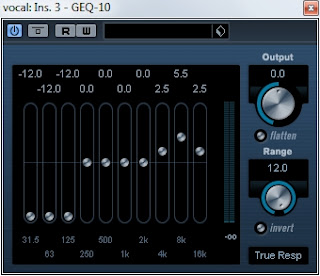
bass boost caused by singing close to the mic).

EQ can easily address excessive bass that was captured due to the proximity effect (ie. I recommend using the upper bass and mid-range as the ‘reference’ for vocal EQ - try leaving that region alone while you work first on the lows and then the upper mid-range and highs. For female vocals, the formant tone (which gives vocals much of their character) will be somewhat higher, so if these ranges don’t work try moving them up about half an octave. This EQ shows many of the tweaks I’ve mentioned: a high-pass filter to counter proximity-effect bass boost a high-frequency shelf boost to bring out air and transparency an upper-mid boost to increase intelligibility, so the vocal can ‘cut’ more and a tiny lower mid-range dip.When it comes to applying EQ, there are three main areas it can help to consider adjusting for the male voice (which is primarily what I work with): the lows, below about 150-200 Hz the lower mid-range, around 300-400 Hz the upper mid-range, in the 2-4 kHz range and the highs, which can overlap the upper mids. My point here is that before you even reach for an EQ and start tweaking, you really need to make an effort first to listen to the part and then decide how you want it to sound.

Similarly, keep an ear out for what any other processing such as compression and analogue tape emulation does to the tonal balance of the vocal. Mic selection isn’t really a mix issue, of course (unless, I suppose, you’re deliberately using one of the new crop of modelling mics), but it’s well worth listening out for what the mics might have added. cardioid) mics will add bass boost due to the proximity effect if they’re used close to the source (as they almost always are for vocals). The mic itself may already have added a first stage of equalisation - most large-diaphragm condenser mics (and a fair few dynamics) have a natural ‘lift’ in the vocal range, and directional (eg. Judicious equalisation (EQ) obviously helps a vocal sit well in the mix, but note that ‘EQ’ isn’t the preserve of dedicated equalisers. That said, there are certain constants you’ll encounter with almost every vocal and it’s those I’ll address here. Much of what makes for a good mix is highly subjective and the same goes for vocal sounds too: every voice is different and we all have different tastes. This time, I’ll run through what you can do to perfect your vocals during the mix itself. In Part 1 of this two-part series, I explained some ways to prepare your vocal recordings to maximise your chances of a good result in the mix. I tend to blend a little of all three to get the vocals to sit just right.Īdding reverb will almost always make the vocals feel like they are being pushed back in the mix, but you can add a little predelay (50-100 ms) to make the vocalist feel like they are close to the listener, but still in a large room.Part 2: Having created the conditions for a successful mix last month, what can you do to fit your vocal in the mix? My favorites are plate (tight, high frequencies, linear decay), hall (usually dull sounding, 3D, lush), and room (tight, early reflections, width). Without getting too much into the nuances of reverb, there are a few different types that have different sounds. If you to gel your vocals with other instruments, this is my favorite way to do it. Instead, just using a delay might be a better option.


Depending on what you are trying to achieve, you may not need to add any reverb at all (very dry, clear vocal sound).


 0 kommentar(er)
0 kommentar(er)
